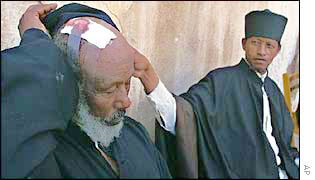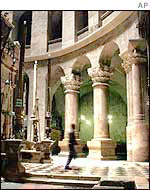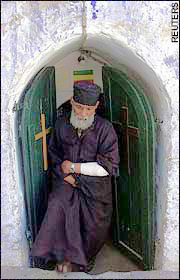
Iron bars and chairs were thrown during the row
Thank Goodness they're all Christians
July 30, 2002 -
Jerusalem
By Yair Sheleg with Alan Philps and wire services

Iron bars and chairs were thrown during the row |
Eleven monks were treated in hospital after a fight broke out for control of the roof of the Church of the Holy Sepulchre in Jerusalem, the traditional site of Jesus' crucifixion, burial and resurrection. It is not the first time monks have come to blows at Christendom's most holy place, but it is one of the most serious in recent times. As black-clad monks threw stones and iron bars at each other, the Israeli police were called to restore order.
Mounting tension between Ethiopian and Coptic priests, monks and nuns over the
strict rules defining control over parts of the Holy Sepulchre's roof, yesterday
broke out into an all-out fistfight as Coptic and Ethiopian priests argued that
each side had violated the sensitive status quo governing the division of the
roof between them.
The fight, which included stone throwing, ended with injuries for about a dozen
of the priests from both sides who needed medical treatment.

The church is controlled by six different orders
"The church is a
cockpit of rivalry between Christian sects and, in the words of one
historian, the "most unchristian place in the world". It is shared among six
denominations, with the more powerful ones taking ruthless advantage of any
weakness by their rivals." |
The church, traditional scene of the site of Jesus Christ's crucifixion and resurrection, has long been a source of disputes among various churches over who controls the various parts of it. A deal worked out in 1757 gave specific control to each church over specific parts of the church and violations -whether accidental or deliberate and sometimes over the most petty questions of who cleans where inside the ancient chambers of the church - can result in flare-ups of violence as occurred yesterday.
The specific dispute between the Copts and the Ethiopians is over the roof, and goes back to a 19th century epidemic that killed off the Ethiopians, who had control over the entire roof. That enabled the the Egyptian Copts to take over the roof, says Hagai Siton, the attorney for the Ethiopians. But the British Mandatory authorities resurrected the 1757 division, giving the roof and its buildings to the Ethiopians, but the small monastery on the roof to the Copts.
 An Ethiopian monk nurses his bruises after the clash |
According to the agreement, a Coptic priest sits guard at the entrance to the
monastery, and he has a room inside the courtyard controlled by the Ethiopians.
But a month ago the Coptic monk assigned to sit outside the monastery moved his
chair to the shade of a tree inside the courtyard controlled by the Ethiopians.
They demanded he move his chair back, and he refused, claiming he was ill and
needed his rest.
The police, called to intercede, ruled the aging monk would be allowed to sit in
the courtyard for 10 to 15 minutes a day, accompanied by a policeman, and then
go back to his seat outside the courtyard, at the entrance. The Ethiopians
objected and complained to the Public Security Ministry and the Religious
Affairs Ministry.
Tension has mounted since the chair was originally moved, and yesterday's
fistfight broke out when a Coptic monk complained that an Ethiopian nun tried to
touch him. The Copts threw rocks at the Ethiopians, claiming the Ethiopians
threw rocks back, but the Ethiopians deny it.
After the fracas, the Ethiopian ambassador
to Israel arrived on the scene and said his government would take control of the
matter and resolve it through diplomatic channels with the Egyptians, and not
through the legal channels in Israel. In that case, Jerusalem is likely to come
under pressure from Addis Ababa and Cairo as the two capitals apply pressure on
the government to resolve the matter to their satisfaction.
Yesterday there was a silent stand-off on the roof, with the Ethiopians defending their property with a row of chairs.
| Final score | |
| Ethiopian Orthodox Christian monks | Coptic Christian Church of Egypt monks |
| 7 injured, 1 still unconscious | 4 injured |
| defending property with a row of chairs | 1 aging monk allowed to sit in the courtyard for 10 to 15 minutes a day, accompanied by a policeman, then go back to his seat outside the courtyard |
| filed appeal with Public Security Ministry and the Religious Affairs Ministry | |
Sources:
Other Stories:
Links:
|
||||||||